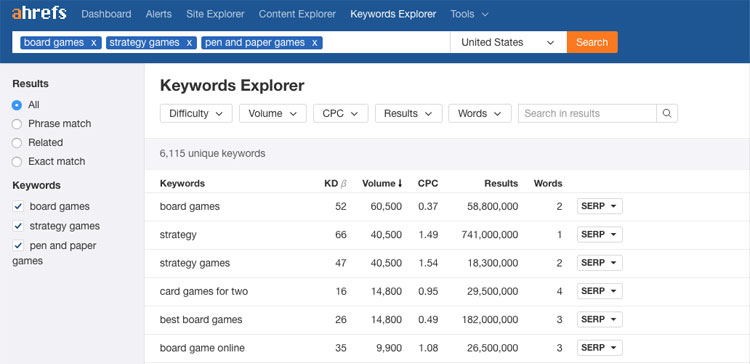Keywords play a critical role in helping boost your blog SEO by positioning your business as relevant and current.
Before you sit down and rush out a dozen blogs filled with keywords, consider the advice below first.
What is Search Engine Optimization?
Search engine optimization is organic. It is about how web users find your business online. The more tactics you employ, the more likely your website will be in the front pages of the search engine (whether it’s Google, Bing or others), the easier it will be for the web user to find your business. Keyword Research is very important and plays a vital role in Search Engine Optimization. That's why it is always recommended to choose the best keywords for SEO.
It is a symbiotic reaction. The more ‘visible’ your website is, the more ‘hits’ it will garner and therefore the higher it will rank. High ranking websites eventually become ‘top of mind’ recall for web users. If they are searching for a product or service category that your business represents, they will instantly remember you first. They are also more likely to share this knowledge with others in their community
SEO is not similar to Google AdWords where you pay to be ranked highly on Google Search Engine. SEO is a digital marketing strategy that uses a combination of tactics and practices to expand your website reachability.

Five Keyword tips to improve your blog SEO
Keyword plays an important role in helping your business website rank higher in search engines. Keywords are the most common words a web user will use when he/she is searching for a product, service or site.
Keywords have to be used properly in order to show results. Check out some basic importance of keywords in SEO.
1. Keywords and Long Tail Keywords
The keyword is all the rage in digital marketing today. Every company is busy running a keyword search and littering their blog posts with dozens of these ‘most commonly used words’ or keywords. Sadly their efforts will not be rewarded. In some cases, they could be punished by Google.
Here’s an example:
Let’s say ‘Company A’ sells bargain shoes from Europe. They have decided to use three keywords ‘cheap’, ‘shoes’ and ‘Europe’ to write a blog to introduce their online store.
If you love shoes, you will love buying ‘Company A’ cheap shoes. They have cheap shoes from all over Europe. The shoes come from Europe and they are very cheap.’
Blogs that do not provide a good reading experience will not pass Google’s stringent checks. As a matter of fact, if you stuffed too many keywords into your blog, Google may think it is an illegal black hat activity and penalize your site for it.
Try using 1 or 2 long tail keywords that match your reader’s intent. Long tail keywords are a collection of words to form a phrase or part of a phrase that will have some meaning for the web searcher.
It’s important that your blog has something to offer whether it’s a new piece of information, a new skill, an amusement factor or an entertainment value. Google’s ranking can now measure intent so balance your keywords with long tail keywords so your blogs read better.
One of the most common ways to use long-tail keywords is as a question. These longer keyword forms help you stay on point with your discussion and will motivate the reader to want to finish reading your piece.

2. Keyword Placement
Good content needs careful thought and planning. Don’t randomly throw keywords everywhere in your article. Try to create variety by placing keywords in the heading, sub-headings as well as the content.
Always remember that blogs are not meant to sell. Leave the selling to other parts of your website.
Your blog is a unique platform to help you engage and connect with readers. So even if you only include the bare minimum number of keywords in your article, if it is really a value-add to your reader, he/she will still be sharing and telling others about what they’ve read.
3. Using proper Title Tags
Title tags are the headlines. They are the first thing a reader sees to determine if it’s worth reading on.
Place your keyword within the first 60-characters of your title. That’s where Google’s titles cut off on SERPs (search engine results pages). Google doesn’t measure with character count, they measure the pixel width (approximately 500-600 pixels will translate to around 60 characters).
4- Writing a suitable Meta Description
The meta description appears in the SERPs. They provide information to the reader to help them determine if your blog article is what they should be reading to achieve their intended goal. Meta descriptions go up to 300 characters and the purpose is for you to give enough reasons to compel the reader to read your article. Include long tail keywords with your meta description to create maximum appeal.
5. Adding an Alt Text
Blogs are not just text. Images and videos can add value to your blogs and helped them rank higher.
Search engines can’t technically ‘see’ an image you upload so the alt text plays a key role in describing the image.
Adding keywords to your ‘alt text’ takes only a minute or so but it’s worth the effort to give the reader a better experience and to help Google identify and confirm that the images you are using are relevant to the text or content.
There are many more things your business can do to maximize your blog SEO. We have only touched on the surface of how keywords can play a critical role in improving blogs SEO. If your business is considering venturing into blogs production, take a step backward and plan how you intend to incorporate your keyword approach into the overall strategy.
For more information on the blog, SEO calls the experts at GoForPost today.